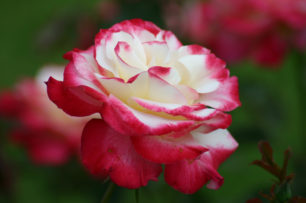Are you looking for some late season color or something to fill a gap in a shrub or perennial border where a plant was lost or under performing due to last winter?
It is time to consider roses. Yes, ROSES! Roses are traditionally promoted as spring items, especially as gifts for Mother’s Day, but the late summer/fall season, from August 15 until September 15, is actually perhaps the best season to plant new roses, or to transplant existing ones.
As we are all aware, spring weather can be highly variable with early high temperatures of 70-80 degrees that can cause early bud expansion, and late freezes until Memorial Day which can damage new soft growth, resulting in dieback, or delaying leaf and flower development. Alternating heavy rains and drought conditions can stress plants more.
Even in “normal” years, mid-August typically brings cooler night temperatures, greater differential between day and night temperatures, and plentiful, regular rainfall, all good things for new plantings. Additionally, as the days grow shorter, plants are programed to begin to store sugars in plant tissues, forming new roots and dormant buds for next spring. You can take advantage of this natural cycle to get your plants in the ground and established while they still have three to four months to make roots and store sugars until the ground freezes and they finally go dormant for the year. This puts them well ahead of those to be installed next spring. Besides having to overcome the shock of transplanting, spring planted roses must push new top growth often with limited reserves, and insufficient root growth to sustain them through varying weather conditions. Established plants are much better able to withstand all the weather extremes of spring.
Those who claim that roses are hard to grow probably have not tried late summer planting. It is still important to choose varieties that meet your design criteria, are rated hardy for the area, and are installed with proper amendments according to your soil test results. Application of a little additional bark mulch cover in late fall around Thanksgiving will help to keep the new plants dormant during winter, and insure successful regrowth in spring.
Wenke Greenhouses will begin offering a new selection of hardy roses for fall planting. These plants have been grown on their own roots rather than produced from grafting on an understock. Own-root plants, although not widely available at most garden centers, generally perform better under difficult climate situations of temperature and rainfall extremes. Knowledgeable gardeners often seek own-root rose plants, but typically they only are able to find rooted cuttings, which will take years to mature. Wenke Greenhouses will have these own-root roses available for purchase beginning Tuesday August 5th, 2014 and while supplies last through the The Festival of Flowers and Fragrance on August 16th, 2014.
Come check out our selection of many color choices, most have very fragrant blooms all season, and their natural disease resistance offers added benefits of more color for less work in the garden. We will have several climbing varieties, David Austin English Roses, shrubs and even some miniatures. Late summer/ early fall truly is a good time to plant roses.
By Joyce Latta from the Southwest Michigan Celebration of Roses, the regional American Rose Society affiliated group


